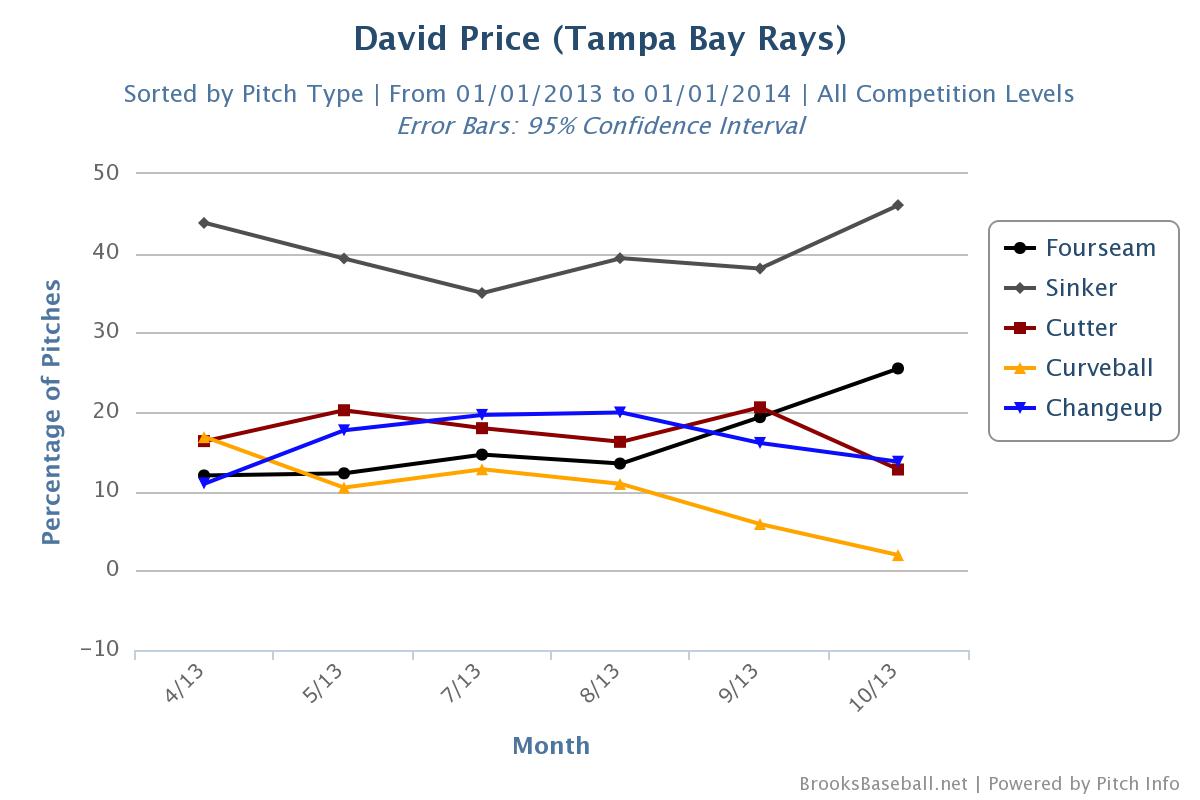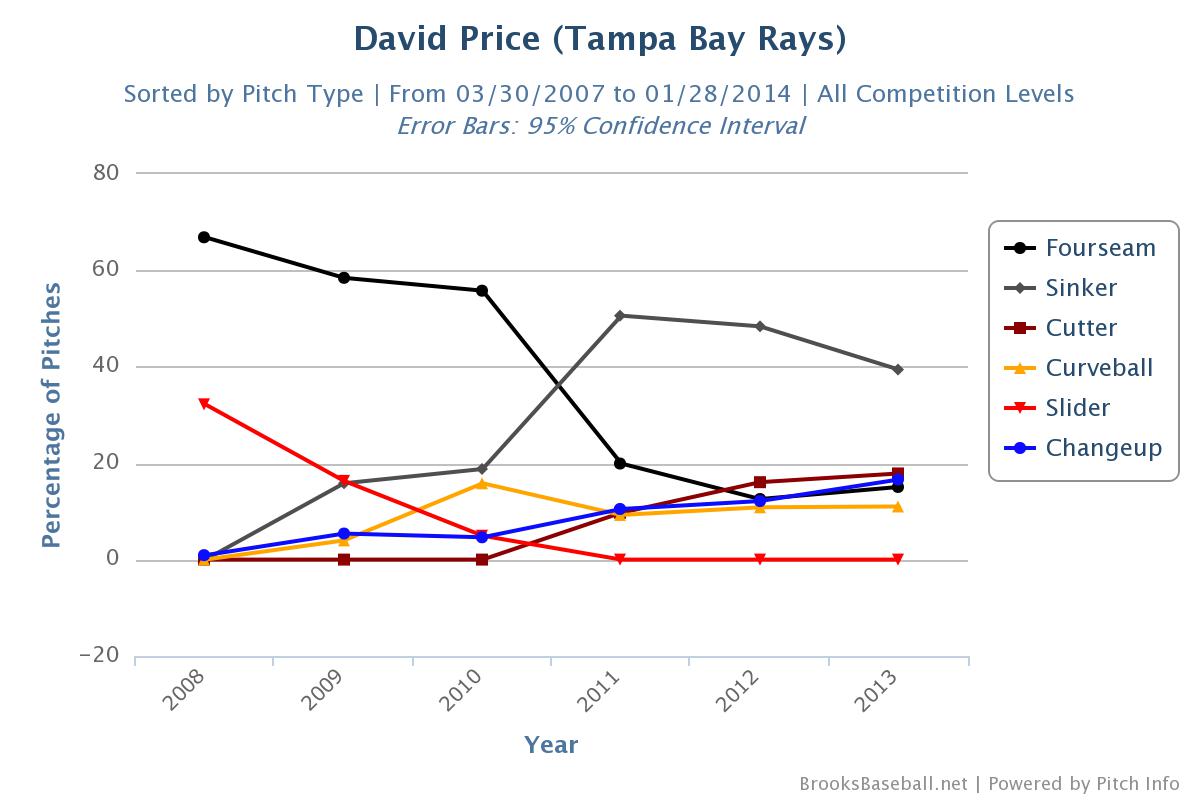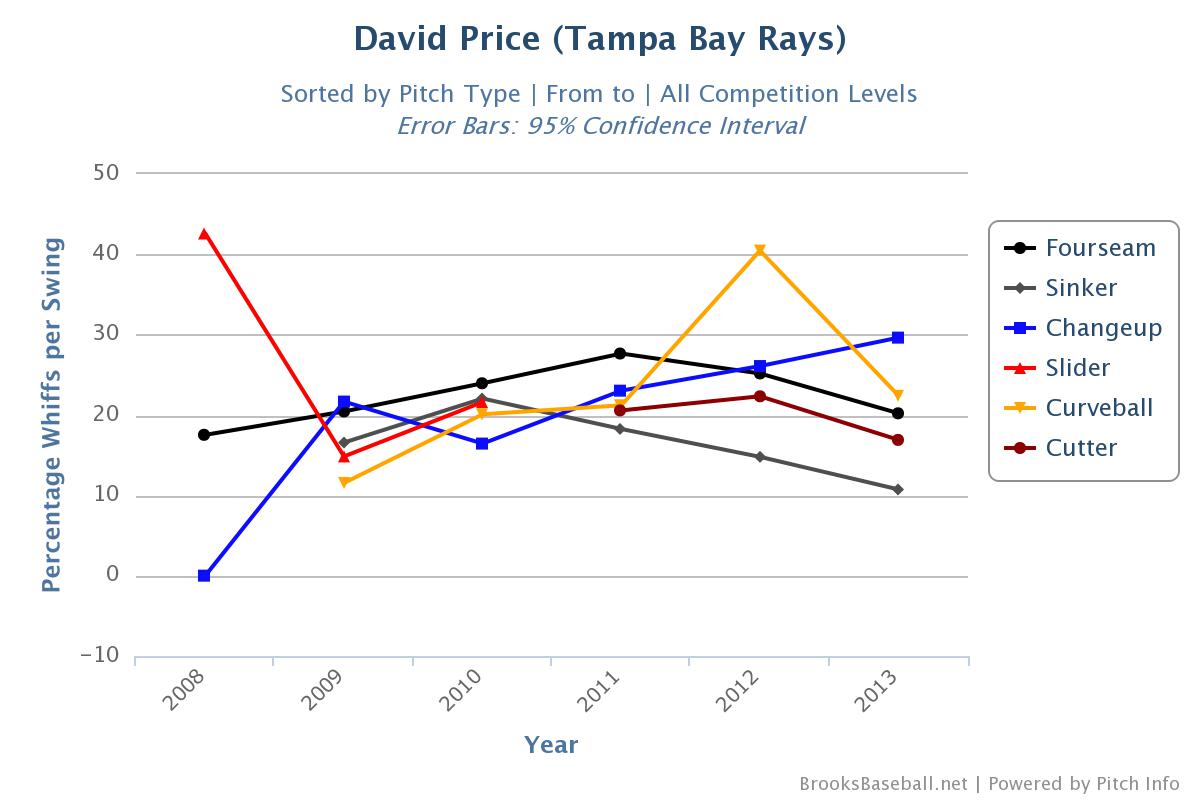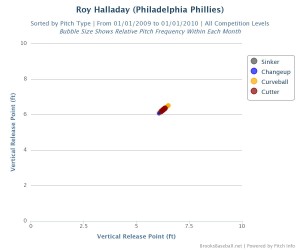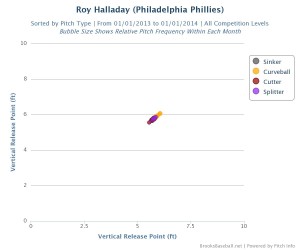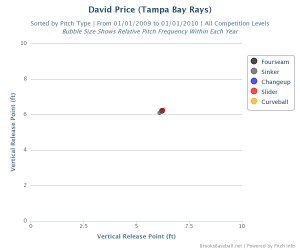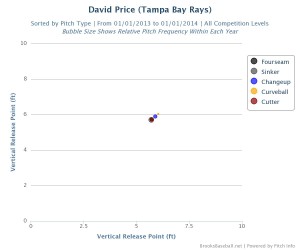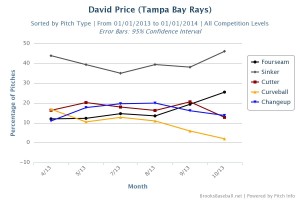2014 Fantasy Baseball: David Price Continues to Change
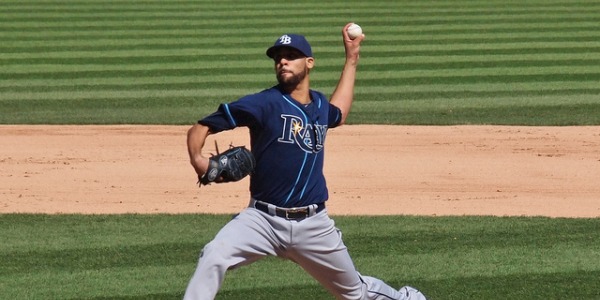

As life goes on, things change. Some change is good, some change is bad, and sometimes it is just indifferent. We may not even know which until it happens. The future, after all, is tough to predict. Yet, we continue to try, especially with fantasy baseball. So, maybe we fit the definition of insanity? I much rather call it persistence.
This persistence has led me to look at the developments of David Price. He has been one of the league’s best pitchers the last several seasons. And a top fantasy starter. But we change. Players change.
And David Price is changing.
Last year, despite a strained triceps, Price pitched well, but there were some noticeable trends. In 2013, Price’s fastball was 93.5 MPH. In 2012, it was 95.5. A two mile-per-hour difference is quite significant. Here is his fourseam fastball velocity charted by month:
|
Month |
Fourseam |
|
4/13 |
93.82 |
|
5/13 |
92.27 |
|
7/13 |
93.97 |
|
8/13 |
93.26 |
|
9/13 |
93.52 |
|
10/13 |
93.04 |
His velocity was pretty consistent before and after the injury. He had only one start in October. Price pitched three times in May, while the injury shortened his final start to 2.1 innings. May was also is the lowest velocity of any month, but one of the games took place at Coors Field, which had a low of 33 degrees that day. Price’s fastball didn’t even average 91 during the outing. Let’s chalk that up to the weather.
The decline in velocity comes along with a decline in strikeouts. Price K’d 20.4% (7.28 K/9) of batters faced last season, which leaves him right around league average. And when you read into his swinging strike past, there is concern the K’s won’t come back, at least not to his 2012 levels (24.5%, 8.74 K/9).
|
Season |
SwStr% |
|
2008 |
12.3 % |
|
2009 |
7.5 % |
|
2010 |
9.8 % |
|
2011 |
8.4 % |
|
2012 |
8.3 % |
|
2013 |
7.9 % |
Price’s swinging strike percentage has been average or below the last three seasons. Despite this fact, he has managed to post an above average strikeout rate for most of his career. But there are some transformations taking place.
This is a chart of Price’s pitch usage. BrooksBaseball.net classifies his most used pitch as a sinker. In case you were wondering, Price’s sinker is delivered with almost the same velocity as his fourseamer, and it also had a near two miles-per-hour drop from 2012. As the season continued, he increased the usage of his fastball and sinker, while slowly ditching the curveball and decreasing the use of his changeup. The interesting part is this isn’t a one year trend. Take a look at his career pitch usage.
This is the evolution of David Price. The genesis of the evolution was during the 2010 season, and it has only grown from there. The slider has been replaced by the cutter, while the sinker has jumped way ahead of the fourseam fastball. The changeup has slowly increased over time, and yet Price threw it less as the season went on in 2013. Here is how the left-hander used his arsenal last season:
|
David Price (2013) |
Fourseam |
Sinker |
Cutter |
Curve |
Change |
||
|
LHH |
|||||||
|
All Counts |
13% |
67% |
6% |
12% |
2% |
||
|
First Pitch |
13% |
64% |
5% |
16% |
3% |
||
|
Batter Ahead |
11% |
77% |
5% |
6% |
1% |
||
|
Even |
12% |
65% |
6% |
15% |
2% |
||
|
Pitcher Ahead |
16% |
63% |
6% |
13% |
2% |
||
|
Two Strikes |
16% |
68% |
5% |
10% |
2% |
||
|
RHH |
|||||||
|
All Counts |
16% |
30% |
22% |
11% |
21% |
||
|
First Pitch |
15% |
36% |
15% |
10% |
24% |
||
|
Batter Ahead |
16% |
30% |
20% |
2% |
31% |
||
|
Even |
15% |
32% |
20% |
10% |
23% |
||
|
Pitcher Ahead |
16% |
28% |
26% |
17% |
13% |
||
|
Two Strikes |
17% |
27% |
31% |
12% |
13% |
||
As a southpaw, it is interesting to see Price stick with the sinker against lefty hitters. The cutter is barely used and even the curveball doesn’t get much love. His usage versus right-handed hitters is more balanced, but with two strikes, Price still relies on the cutter and sinker more than anything else. Perhaps Price is getting enough whiffs with this pitch selection?
Whiff Percentage:
|
Year |
Fourseam |
Sinker |
Change |
Curve |
Cutter |
|
2013 |
9.29 |
4.82 |
17.28 |
9.77 |
7.23 |
Percentage of Whiffs per Swing:
|
Year |
Fourseam |
Sinker |
Change |
Curve |
Cutter |
|
2013 |
20.21 |
10.73 |
29.63 |
22.39 |
16.90 |
Considering the decline in velocity, the fourseam whiffs are encouraging. However, in comparison to his peers, Price could stand to do better elsewhere. His changeup appears to be the most promising, coming in at about league average, but the sinker isn’t inducing enough swings and misses. The cutter is less than average at getting whiffs compared to other starting pitchers too. And when Price is again compared to others, the whiffs on his curveball come up short. He is getting below average whiffs on the sinker, curve, and cutter. Out of 257 starters with at least 200 pitches thrown, Price ranked 181st in Whiff/Swing%.
Here is a career look at Price’s whiffs per swing:
When you take into account the usage of his sinker, and even the cutter versus right-handed hitters, one would expect to see Price at the top of the leaderboard when it came to groundballs, but that was not the case in 2013. The sinker was better at inducing grounders during the 2012 season (as shown by his overall 53.1 GB%), however it still didn’t land Price in the top-50 among starters. In 2013, he had a 44.9% overall ground ball rate, which is right around league average.
What Price did achieve last season was a big time reduction in walks. He already had a low walk percentage in prior seasons, but he took it to a whole new level with a 3.7 BB% (1.30 BB/9) in 2013. That is excellent. He also managed to up his IFFB% to above the league average. In comparison to his career, Price won the ISO battle within the strike zone last season. He has never been one to have a significantly high O-Swing% (slightly below average for his career), so it will be interesting to see what happens if he starts losing those battles.
Price’s 2013 season has a striking resemblance to that of fellow lefty, Cliff Lee, except Lee generated more whiffs and strikeouts. Not to mention better swing and contact rates. Lee has also shown a better walk rate throughout his career. But the overall results and pitch usage are incredibly similar.
Price has succeeded with this approach and whiff rates, but on draft day, many fantasy managers are paying for a top-10 fantasy starter. And top-10 fantasy starters tend to strikeout near a batter per inning these days.
And just how much room is there for error? What if the fastball loses even more zip? What if the whiffs continue to decline? The lower velocity is a real concern, and two mile-per-hour drops should trigger that kind of feeling.
Then there is Price’s release point. Release points are difficult to judge at times, both in accuracy, and what they actually mean. Roy Halladay showed a significant drop in his last season, which you could link to his physical breakdown. As for Price, he has actually shown a drop in release point in every year since 2009.
Here are Roy Halladay’s release points for the 2009 and 2013 seasons:
And now David Price’s release points for the 2009 and 2013 seasons:
They look quite similar, although Price appears to be more consistent with each pitch type. This doesn’t necessarily mean anything, but it is interesting nonetheless. As for the possibility of a future injury, Price was hurt last season, and past injuries are usually the best predictor of future ones.
Breaking balls have been linked to injury in the past and we do see a peculiar trend with Price’s pitch usage. He has thrown less breaking balls as each year passes, and if you again take a look at his 2013 chart of pitches thrown, he did lessen the use of all breaking and off-speed pitches by the end of the season.
Could he still have been bothered by the strained triceps last season? Possibly. Could there be another physical issue that was or still is unknown to us? Hard to say, of course. Perhaps Price is simply molding his game after Cliff Lee.
Throughout life, people change. And so do baseball players as players. Sometimes for the better, and sometimes not. Other times, a ball player’s change is only unfavorable in our fantasy baseball world. It will be fascinating to see what happens with Price’s velocity and health moving forward. We saw a significant drop in his strikeouts, but a big drop in his walk rate. There were subtle differences in his batted ball and swing profiles, such as the increase in IFFB%, but no “ah-ha” moments. Since 2010, the lefty made a change, which has only become more pronounced with each passing year. Maybe David Price decided to put less of an emphasis on strikeouts and pitch this way because he believes it is the best way. And maybe that is true. But it certainly puts a dent into his fantasy value.
Much thanks to BrooksBaseball.net, BaseballProspectus.com, BaseballAnalytics.org, and Fangraphs.com for the data.


